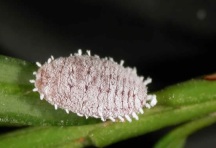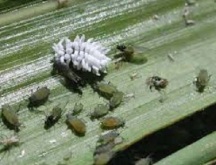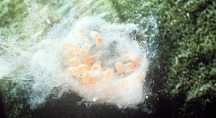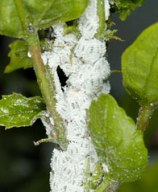You are currently browsing the tag archive for the ‘how to treat mealybug infestation’ tag.
Mealybugs are insects in the family Pseudococcidae, unarmored scale insects found in moist, warm climates. They are considered pests as they feed on plant juices of greenhouse plants, house plants and subtropical trees and also act as a vector for several plant diseases. There are approximately 275 species of mealybugs known to occur throughout the United States.
Description
Mealybugs are very small (about an eighth of an inch long), oval-shaped flightless bugs that have a white powdery appearance and infest both indoor and outdoor plants. They move slowly, when they move at all. Mealybugs are soft-bodied insects, but they secrete a powdery wax layer over themselves. This protective layer gives them their name, as it makes them look as though they’ve been coated in meal or flour. It is also what makes them quite hard to kill.
Mealybug infestations appear on plants as fuzzy, white cottony-looking mass around the stems and leaf nodes. Female mealybugs hide their eggs in this fluffy white excretion and can deposit 300-600 eggs within their compact, cottony mass.
Eggs hatch in 1-3 weeks and small active yellow nymphs move all over the plant in search of feeding sites in which to settle in. As they feed, they secrete honeydew and a waxy coating begins to form over their bodies. Nymphs spend 4-8 weeks developing into the adult form.
Plants they attack
Mealybugs thrive on a wide variety of indoor and outdoor species, including ficus, philodendron, coleus, begonia, citrus plants, fern, dracaena, ivy, poinsettia, cacti and succulents, African violets, bougainvillea, fuchsia, grape vines, hoya, orchids, oleander, passion flower, peach, tomato, potato, pineapple, coffee trees, cassava, papaya, mulberry, sunflower and avocados among others.
Damage and Symptoms
Mealybugs feed on plant sap and generally position themselves under leaves and at stem joints, while they attack the plant with their piercing mouths known as stylets. This penetrative feeding damages the plant by draining its sap and may possibly transmit bacterial and fungal infections. This sap feeding weakens the plant and causes slow plant growth, yellowing and deformed leaves and leaf drop. They also excrete large amounts of sticky ‘honeydew’ that attracts ants and may lead to the growth of sooty mold. Damage is not often significant at low pest levels; however, heavy infestations can kill a plant.
Organic Control and Prevention of Mealybugs
1. The first rule of successfully ridding plants of mealybugs (or any pest for that matter) is to detect and act upon them early. It’s far easier to rid of a small infestation than to eradicate a full-blown attack. Inspect your plants regularly to ensure early detection.
2. The water cure: Isolate the infected plants. Spray as strong a stream of water as the plant can bear. This will dislodge most of the bugs. Kill dislodged bugs, if not already dead. For this to be effective, repeat on a daily basis until the mealybugs are gone.
3. Sanitation and cultural control: It is a good practice to keep your garden and greenhouse clean and void of old and unwanted material. Dead leaves and prunings should be removed as these may have mealybugs or their eggs on them. Do not overwater or over-fertilize as mealybugs are attracted to plants with high nitrogen levels and soft growth.
4. Control ants: Ants feed on the honeydew that mealybugs produce and act as their henchmen by protecting them from predators to ensure their food supply.
5. Organic insecticidal soap: Buy an organic insecticidal soap which utilizes the power of potassium salts of fatty acids that works by weakening the insect’s waxy protective outer shell and spray on infestations. These soaps are generally safe to use on vegetables but always check the label.
6. Rubbing alcohol method: Spot treat mealybug infestations with a cotton ball dipped in rubbing alcohol. Simply dab the critters and rub them away. The alcohol strips away the waxy coating leaving the mealybugs exposed.
7. Organic dishwashing liquid: Any soap will effectively suffocate the mealybugs as the soap coats the bug and also breaks down their protective waxy layer. Just mix the dishwashing soap in water and spray on infestations.
8. Neem oil: Neem oil derived from the neem tree has insecticidal properties in addition to being a fungicide and having systemic benefits.
9. Kitchen insect spray: Combine 1 garlic bulb, 1 small onion and 1 teaspoon of cayenne pepper in a blender. Mix into 1 quart of water and allow it to infuse for an hour. Strain through a cheesecloth and add a tablespoon of organic soap and mix well and spray!
10. Beneficial insects: Beneficial insects and parasites are considered the best long-term solution for mealybug infestations. Ladybirds, lacewings and hover flies kill mealybugs. Parasitic wasps (Leptomastix dactylopii) parasitize mealybug eggs and are an effective method of controlling infestations. There is also a commercially available mealybug predator known as the ‘mealybug destroyer’, which is a small dark brown ladybug (Cryptolaemus montrouzieri) whose preferred food happen to be all the stages of mealybugs.




